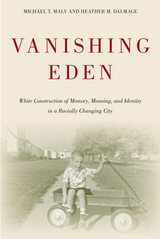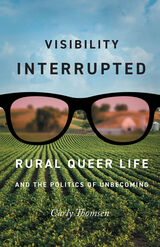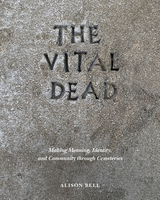3 start with V start with V

For many whites, desegregation initially felt like an attack on their community. But how has the process of racial change affected whites’ understanding of community and race? In Vanishing Eden, Michael Maly and Heather Dalmage provide an intriguing analysis of the experiences and memories of whites who lived in Chicago neighborhoods experiencing racial change during the 1950s through the 1980s. They pay particular attention to examining how young people made sense of what was occurring, and how this experience impacted their lives.
Using a blend of urban studies and whiteness studies, the authors examine how racial solidarity and whiteness were created and maintained—often in subtle and unreflective ways. Vanishing Eden also considers how race is central to the ways social institutions such as housing, education, and employment function. Surveying the shifting social, economic, and racial contexts, the authors explore how race and class at local and national levels shaped the organizing strategies of those whites who chose to stay as racial borders began to change.

A questioning of the belief in the power of LGBTQ visibility through the lives of queer women in the rural Midwest
Today most LGBTQ rights supporters take for granted the virtue of being “out, loud, and proud.” Most also assume that it would be terrible to be LGBTQ in a rural place. By considering moments in which queerness and rurality come into contact, Visibility Interrupted argues that both positions are wrong. In the first monograph on LGBTQ women in the rural Midwest, Carly Thomsen deconstructs the image of the rural as a flat, homogenous, and anachronistic place where LGBTQ people necessarily suffer. And she suggests that visibility is not liberation and will not lead to liberation.
Far from being an unambiguous good, argues Thomsen, visibility politics can, in fact, preclude collective action. They also advance metronormativity, postraciality, and capitalism. To make these interventions, Thomsen develops the theory of unbecoming: interrogating the relationship between that which we celebrate and that which we find disdainful—the past, the rural, politics—is crucial for developing alternative subjectivities and politics. Unbecoming precedes becoming. Drawing from critical race studies, disability studies, and queer Marxism, in addition to feminist and queer studies, the insights of this book will be useful to scholars theorizing issues far beyond sexuality and place and to social justice activists who want to move beyond visibility.

What can a cemetery tell us about the social and cultural dynamics of a place and time? Anthropologist Alison Bell suggests that cemeteries participate in the grassroots cultural work of crafting social connections, even as they test the transcendental durability of the deceased person and provide a measure of a culture’s values. In The Vital Dead, Bell applies this framework to the communities of Virginia’s Shenandoah Valley and the cemeteries that have both claimed them and, paradoxically, sustained them.
Bell surveys objects left on graves, images and epitaphs on grave markers, and other artifacts of material culture to suggest a landscape of symbols maintaining relationships across the threshold of death. She explores cemetery practice and its transformation over time and largely presents her interpretations as a struggle against alienation. Rich in evocative examples both contemporary and historical, Bell’s analysis stems from fieldwork interviews, archival sources, and recent anthropological theory. The book’s chapters range across cemetery types, focusing on African American burials, the grave sites of institutionalized individuals, and modern community memorials. Ultimately, The Vital Dead is an account of how lives, both famous and forgotten, become transformed and energized through the communities and things they leave behind to produce profound and unexpected narratives of mortality. Bell’s deft storytelling coupled with skill for scholarly analysis make for a fascinating and emotionally moving read.
Groundbreaking in its approach, The Vital Dead makes important contributions to cemetery and material culture studies, as well as the fields of anthropology, archaeology, history, geography, and folklore.
READERS
Browse our collection.
PUBLISHERS
See BiblioVault's publisher services.
STUDENT SERVICES
Files for college accessibility offices.
UChicago Accessibility Resources
home | accessibility | search | about | contact us
BiblioVault ® 2001 - 2024
The University of Chicago Press









